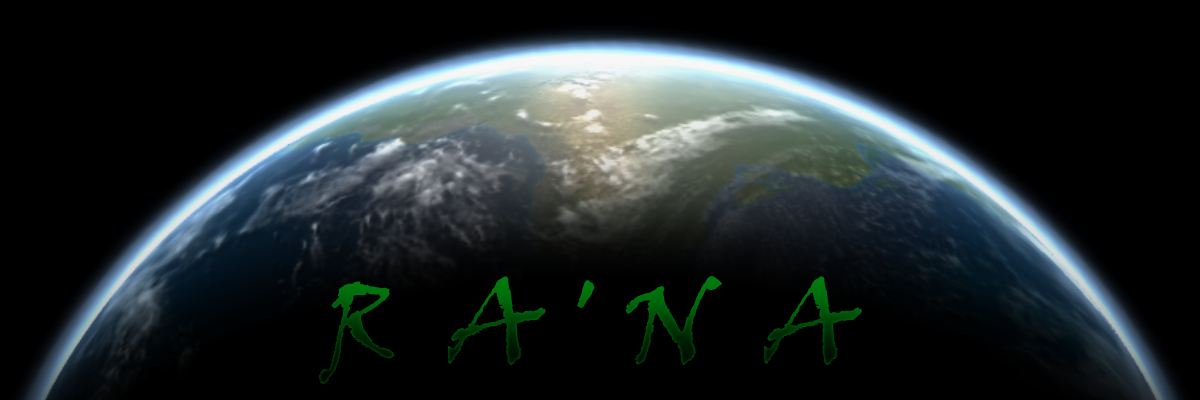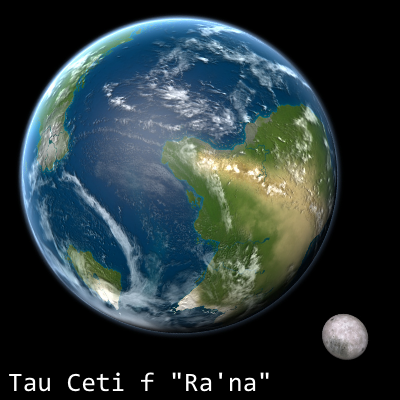Ra'na
The planet Ra/na (anglicized to Ra'na for human pronunciation convenience) is a vibrant world slightly larger than Earth within the Tau Ceti system. It hosts a diverse and thriving biosphere, which includes a single sophont species who call themselves skae.
Geography
Location
Ra'na is the seventh planet out from its sun, Ra/sen (known to humans as Tau Ceti), in close 1:2:4 resonance with its neighbor planets Pon/shol (interior) and Pon/whe (exterior). It has two natural satellites, both small asteroids: Sel/na and Ao/na. Its orbit is more eccentric than most other habitable telluric worlds, leading to rather extreme seasonal variations in surface temperature. However, this eccentricity -combined with tidal influences from the other eight planets in the inner system- have allowed it to avoid tidal locking and maintain its internal magnetic dynamo far longer than a less-eccentric planet of equivalent age.Surface
Landmasses
Ra'na has two independent continents; the other continents form the supercontinent (composed of subcontinents in the northeast, the east/southeast, the center, and the west). Both separate continents detached from the supercontinent millions of years ago and are moving east-southeast. The larger one is also rotating clockwise in its drift, and appears to be on a collision course with the west of the supercontinent. There is one subcontinent which is in the process of colliding with the southern edge of the supercontinent. This geological event, highly similar to the merging of India with Eurasia on Earth, is pushing up a jagged mountain range and is the main reason for the Great Seadeath Desert's appearance. In addition to these, there is also a single sunken continent to the far northeast of the supercontinent. This continent is technically united with the supercontinent, as they share the same plate of the northeast, but the sunken end is being severely eroded and subducted, thus dragging almost all of it below sea level. There are six major archipelagos on the planet, most of which are volcanic/tectonic in origin. The largest of these is by land area is the Northern Archipelago, which was formed by the tectonic fracturing and glacial erosion of the northeastern continent. The Northern Archipelago hosts the two largest islands on the planet as well. The second-largest island chain is the Western Archipelago. These islands were formed by tectonic activity, with the convergence of the oceanic and continental plates compressing and forcing up the seabed.Geological Features
The crust of Ra'na is composed of twenty tectonic plates, eight of which are relatively recently formed. The planet also, notably, hosts an immense, extinct supervolcano caldera which occupies roughly 2% of Ra'na's entire surface area (not even counting its later relative on the eastern caldera lip). Ra'na's millennia of tectonic activity have raised five major mountain ranges.Ecosystem
The Ra'sen system is the origin point of the Ranagenia, an ancient and highly diverse lineage of carbon-based organisms from Ra'na that includes one sophont species: the skae. Ranagenids share many characteristics with other water-solvent, oxygen-CO2 biospheres like Terragenids and Hemeragenids, but are not especially widespread in the cosmos due to the necessity of the relatively rare element vanadium as an enzymatic cofactor.Ranagenid Life
Chemistry
- Hydrogen
- Oxygen
- Nitrogen
- Phosphorous
- Sulfur
Genetics
- Adenine
- Hypoxanthine
- Guanine
- Uracil
Metabolics
- Nicotinamide reversible hydrogen ionization
- Acetyl enzyme oxidation
Structure
Base unit is a phospholipid bilayer cell with internal components in water-based fluid suspension. Genetic material is contained within the cell either in open suspension or within a specialized chamber.Archive Data
HAZARDS
- Sel'na* (asteroid)
- Ao'na* (asteroid)
- 64% nitrogen
- 33.6% oxygen
- 2.3% neon
- 0.1% other gases





















Comments